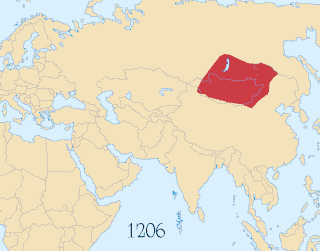
The Mongol Empire of the 13th and 14th centuries was the largest contiguous empire in history. Originating in present-day Mongolia in East Asia, the Mongol Empire at its height stretched from the Sea of Japan to parts of Eastern Europe, extending northward into parts of the Arctic; eastward and southward into parts of the Indian subcontinent, mounted invasions of Southeast Asia, and conquered the Iranian Plateau; and reached westward as far as the Levant and the Carpathian Mountains.

The Chagatai Khanate, also known as the Chagatai Ulus, was a Mongol and later Turkicized khanate that comprised the lands ruled by Chagatai Khan, second son of Genghis Khan, and his descendants and successors. At its height in the late 13th century the khanate extended from the Amu Darya south of the Aral Sea to the Altai Mountains in the border of modern-day Mongolia and China, roughly corresponding to the area once ruled by the Qara Khitai.

The Uzbek Khanate, also known as the Abulkhair Khanate was a Shaybanid state preceding the Khanate of Bukhara. During the few years it existed, the Uzbek Khanate was the preeminent state in Central Asia, ruling over most of modern-day Uzbekistan, much of Kazakhstan and Turkmenistan, and parts of southern Russia. This is the first state of the Abulkhairids, a branch of the Shaybanids.
Tughlugh Timur Khan (1312/13–1363) was the Khan of Moghulistan from c. 1347 and Khan of the whole Chagatai Khanate from c. 1360 until his death. Esen Buqa is believed to be his father. His reign is known for his conversion to Islam and his invasions of Transoxiana.

George VII of the Bagrationi dynasty, was king (mepe) of the Kingdom of Georgia from 1393 until his death in 1407.

The Kazakh Khanate, in eastern sources known as Ulus of the Kazakhs, Ulus of Jochi, Yurt of Urus, was a Kazakh state in Central Asia, successor of the Golden Horde existing from the 15th to the 19th century, centered on the eastern parts of the Desht-i Qipchaq.

Moghulistan, also called the Moghul Khanate or the Eastern Chagatai Khanate, was a Mongol breakaway khanate of the Chagatai Khanate and a historical geographic area north of the Tengri Tagh mountain range, on the border of Central Asia and East Asia. That area today includes parts of Kazakhstan, Kyrgyzstan, and northwest Xinjiang, China. The khanate nominally ruled over the area from the mid-14th century until the late 17th century.
Sultan Said Khan ruled the Yarkent Khanate from September 1514 to July 1533. He was born in the late 15th century in Moghulistan, and he was a direct descendant of the first Moghul Khan, Tughlugh Timur, who had founded the state of Moghulistan in 1348 and ruled until 1363. The Moghuls were turkicized Mongols who had converted to Islam.
Mansur Khan, was the last khan of a united Moghulistan from 1503 until his death. From his father Ahmad Alaq, the previous khan, he inherited the eastern parts of Moghulistan proper, the Muslim oasis cities of Yanqi, Bay, and Kuqa, and the Buddhist "Uighur" holdout of Turfan. He also led a jihad of conquest against Oirat Mongol and Chinese territories to the east, including Hami and Dunhuang, and attempted to convert the Kyrgyz to Islam.

The Dughlat clan was a Mongol clan that served the Chagatai khans as hereditary vassal rulers of several cities in western Tarim Basin, in modern Xinjiang, from the 14th century until the 16th century. The most famous member of the clan, Mirza Muhammad Haidar, was a military adventurer, historian, and the ruler of Kashmir (1541–1551). His historical work, the Tarikh-i Rashidi, provides much of the information known about the family.
The Qara'unas or Negüderi were the Mongols who settled in Afghanistan after moving from Turkestan and Mongolia.

Qamar-ud-din Khan Dughlat was a Mongol ruler of Moghulistan between 1368 and 1392. He belonged to the Dughlat clan of Mongol warlords.
Khizr Khwaja Khan was the son of Tughlugh Timur and Khan of Moghulistan during the Chagatai Khanate, reigning from 1390 to 1399 AD.

The Yarkent Khanate, also known as the Yarkand Khanate and the Kashghar Khanate, was a Sunni Muslim Turkic state ruled by the Mongol descendants of Chagatai Khan. It was founded by Sultan Said Khan in 1514 as a western offshoot of Moghulistan, itself an eastern offshoot of the Chagatai Khanate. It was eventually conquered by the Dzungar Khanate in 1705.
The Battle of Buir Lake was fought between the Ming and Northern Yuan dynasties at the Buir Lake in 1388. The Ming army was led by General Lan Yu, who undertook the military campaign against the Northern Yuan horde led by Tögüs Temür. The Ming army defeated the Northern Yuan horde at the Buir Lake and captured many of their people.
Mihr Nigar Khanum was the first wife of Sultan Ahmed Mirza, the King of Samarkand and Bukhara. She was a princess of Moghulistan by birth and was the eldest daughter of Yunus Khan, the Great Khan of Moghulistan and his chief consort Aisan Daulat Begum. She was also the aunt of Emperor Babur, the founder of the Mughal Empire of India as well as its first Emperor.
The division of the Mongol Empire began after Möngke Khan died in 1259 in the siege of Diaoyu Castle with no declared successor, precipitating infighting between members of the Tolui family line for the title of khagan that escalated into the Toluid Civil War. This civil war, along with the Berke–Hulagu war and the subsequent Kaidu–Kublai war, greatly weakened the authority of the great khan over the entirety of the Mongol Empire, and the empire fractured into four khanates: the Golden Horde in Eastern Europe, the Chagatai Khanate in Central Asia, the Ilkhanate in Iran, and the Yuan dynasty in China based in modern-day Beijing – although the Yuan emperors held the nominal title of khagan of the empire.
The siege of Tbilisi was the successful siege of the city of Tbilisi, capital of the Kingdom of Georgia, by the Turco-Mongol conqueror Timur, which ended on 22 November 1386. The official history of his reign, Zafarnama, represents this invasion in Georgia as a jihad.

The Timurid conquests and invasions started in the seventh decade of the 14th century with Timur's control over Chagatai Khanate and ended at the start of the 15th century with the death of Timur. Due to the sheer scale of Timur's wars, and the fact that he was generally undefeated in battle, he has been regarded as one of the most successful military commanders of all time. These wars resulted in the supremacy of Timur over Central Asia, Persia, the Caucasus, the Levant, and parts of South Asia and Eastern Europe, and also the formation of the short-lived Timurid Empire.
Haqnazar Haider Sultan bin Qasim Khan, commonly known as Haqnazar Khan, was the khan of the Kazakh khanate from 1538-1580. He was the second-oldest son of Qasim Khan and the younger brother of Muhammed Khan.










